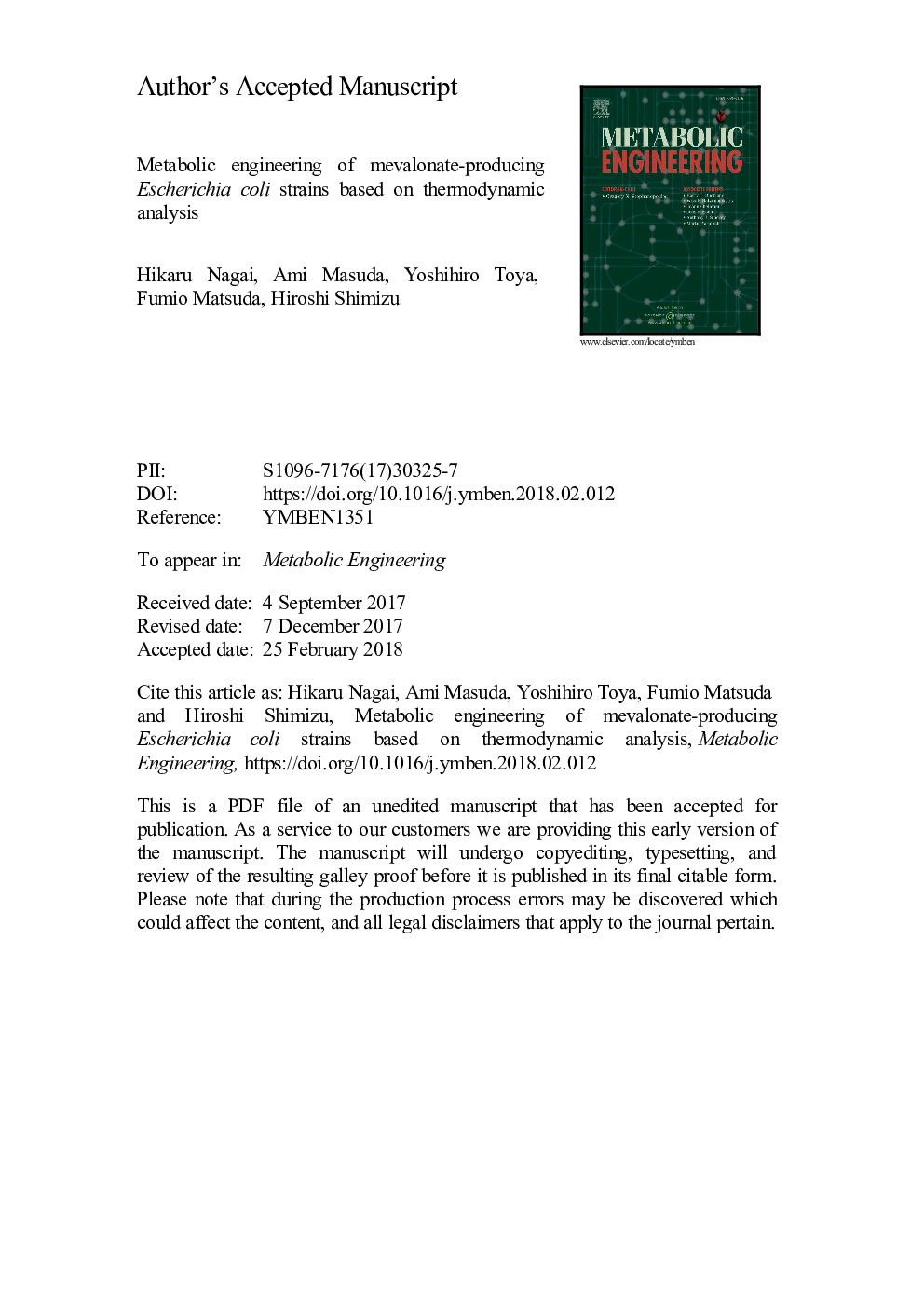| Article ID | Journal | Published Year | Pages | File Type |
|---|---|---|---|---|
| 6494060 | Metabolic Engineering | 2018 | 43 Pages |
Abstract
Thermodynamic states of the central metabolism in a metabolically engineered Escherichia coli strain producing mevalonate (MVA) were studied to identify metabolic reactions with regulatory function for improvement of the specific rate of MVA production. Intracellular concentrations of metabolites were determined for E. coli strains expressing Enterococcus faecalis genes mvaE and mvaS (strain MV) by gas chromatography (GC)- and liquid chromatography (LC)-mass spectrometry (MS). Mixtures of 13C-labeled metabolites served as internal standards were prepared from E. coli cultured in a completely 13C-labeled medium. Based on the concentration data, the change in Gibbs energy (ÎG) and substrate saturation ([S]/KM) were calculated for each metabolic reaction and then compared between the control and MVA-producing strains. The thermodynamic and kinetic analyses showed that further activation of thermodynamically feasible reactions in the upper part of glycolysis and the pentose phosphate pathway seems difficult and that metabolic bypassing to the Entner-Doudoroff pathway was a promising strategy to improve the acetyl coenzyme A (AcCoA) and NADPH supply required for MVA biosynthesis. Strain MV-ÎGndÎGntR was constructed by deletion of the gnd and gntR genes, which respectively encode 6-phosphogluconate dehydrogenase and a negative regulator of the expression of two enzyme genes responsible for the Entner-Doudoroff pathway. Cultivation in the nongrowth phase revealed that the yield and specific production rate of MVA increased to 0.49â¯Â±â¯0.01â¯Cmolâ¯(Cmol glucose)â1 and 2.61â¯Â±â¯0.10â¯mmolâ¯(g dry cell weight)â1 hâ1, which were 113% and 158% that of the MV strain, respectively.
Keywords
E4PPEP6PGCITCOASUCRU5PPTSRPE2PG6PGDHHMG-CoAAcCoArPIG6PPDHEntner–Doudoroff pathwayPFKPYRG6PDHXu5PS7PR5POGDCIPTGPGI6PGLMevalonateaKGFBAF6PDHAPFBPTHDMAL3PGACOGPM2-phosphoglycerate3-phosphoglycerate3-hydroxy-3-methylglutaryl-coenzyme A6-phosphogluconolactonase6-phosphogluconate dehydrogenase6-phosphogluconateNAD(H)NADP(H)FUMα-ketoglutaratemalic enzymeErythrose 4-phosphateTALacetyl coenzyme AEscherichia coliIsocitrateIsocitrate dehydrogenaseisopropyl β-D-1-thiogalactopyranosideMAETransaldolaseTransketolaseMichaelis–Menten constantICDdihydroxyacetone phosphateribose 5-phosphateRibose-5-phosphate isomeraseribulose 5-phosphatexylulose 5-phosphatesedoheptulose 7-phosphateSuccinateCitratephosphotransferase systemfructose 1,6-bisphosphateFructose 6-phosphateFructose-bisphosphate aldolasePhosphoglucose isomerasephosphoenolpyruvatePhosphofructokinasephosphoglycerate mutasemalateMVAOxidative pentose phosphate pathwaynicotinamide adenine dinucleotidenicotinamide adenine dinucleotide phosphatePyruvatepyruvate dehydrogenasepyruvate kinasePYKTCA cycletricarboxylic acid cyclecoenzyme Aglucose-6-phosphateglucose-6-phosphate dehydrogenase
Related Topics
Physical Sciences and Engineering
Chemical Engineering
Bioengineering
Authors
Hikaru Nagai, Ami Masuda, Yoshihiro Toya, Fumio Matsuda, Hiroshi Shimizu,
